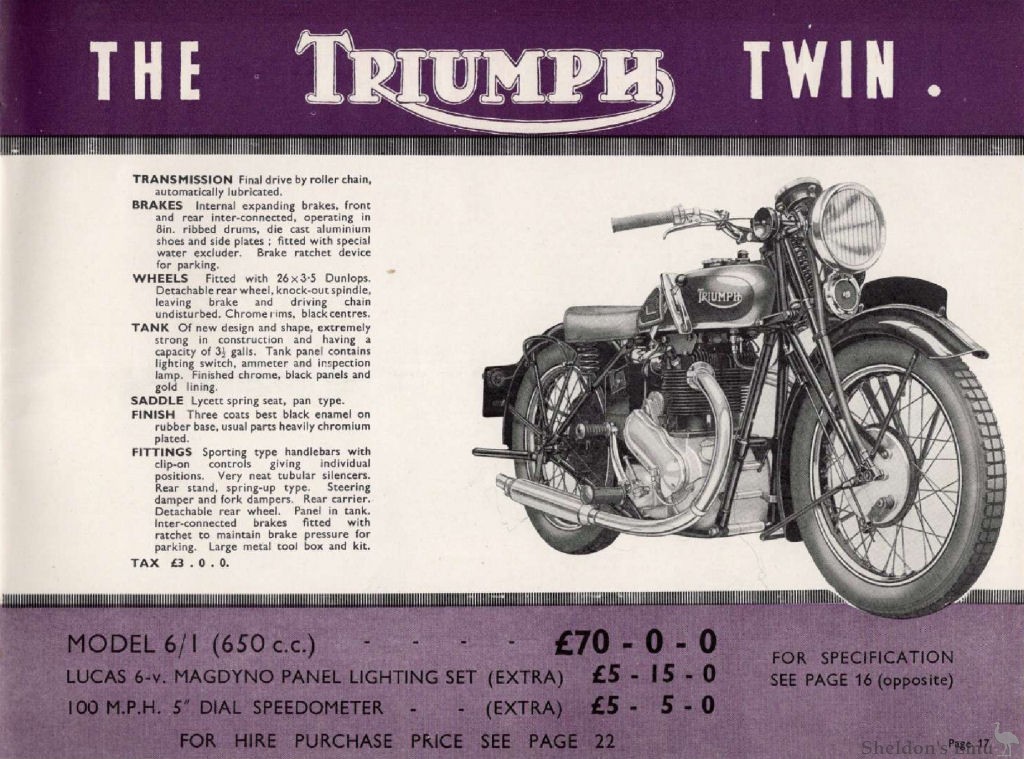



Triumph 6/1 la primera bicilíndrica vertical de la marca
El primer bicilíndrico vertical de producción de Triumph no fue, como muchos creen, el Speed Twin de 1937 de Edward Turner sino el Modelo 6/1 de Valentine Page.
Hacia fines de 1932 Page dejó Ariel para ocupar un nuevo cargo en una Triumph con aprietos económicos donde diseñó una gama de confiables pero nada brillantes monocilindricas y un bicilíndrico, el 6/1.
Introducido en 1933 como un nuevo modelo para la temporada 1934, el doble cilindro en paralelo de 649cc (70 mm x 84 mm) tenía un cigüeñal de 360 grados y un solo árbol de levas accionado por engranajes montado en la parte posterior del bloque de cilindros. La transmisión primaria era por un par de engranajes helicoidales grandes sin engranaje intermedio, lo que significaba que el motor giraba hacia atrás.
Las culatas se formaron a partir de dos piezas fundidas separadas y, con un concepto ya anticuado, tenían el tren de válvulas expuesto. El diseño presentaba un único carburador Amal 276 de 1” para lograr un buen flujo a bajas revoluciones. La potencia era de 25 HP a 4.500 rpm y la velocidad declarada de 135 Km/h.
Curiosamente, el motor se desplazó a la derecha en el cuadro y una caja de cambios de cuatro velocidades abulonada al motor (con cambio manual en los primeros modelos) completaba la unidad motriz. Robustamente construido y pesando 187 Kg, el 6/1 era principalmente adecuado para el uso con sidecar.
Pero por diversos motivos (quizás el mercado no estaba aún listo para el 6/1, o la economía todavía estaba demasiado debilitada para una moto costosa, o el diseño simplemente no era lo suficientemente atractivo) el modelo fue poco vendido. La producción total se estima en unas cien unidades construidas durante los dos años de vida del modelo.
En 1936 Edward Turner llega a Triumph (después de haber seguido a Val Page de Ariel) y rápidamente se encargó de actualizar la línea de modelos y así fue que el 6/1 desapareció de los catálogos.
Source: Sergio Scalerandi
Triumph 6/1 - Their first vertical twin
Triumph's first production upright twin was not, as many believe, Edward Turner's 1937 Speed Twin. It was Valentine Page's Model 6/1.
Towards the end of 1932 Val Page left Ariel for a new position at a struggling Triumph where he designed a range of reliable but unremarkable singles and a twin, the 6/1.
Introduced in 1933 as a new model for the 1934 season, the 649cc (70mm x 84mm) parallel twin had a 360 degree crankshaft and a single gear-driven camshaft mounted at the rear of the cylinder block. The primary drive was by a pair of large helical gears with no idler gear, which meant the motor ran backwards.
The cylinder heads were formed from two separate castings and had an exposed valve train - a somewhat outdated arrangement. The design featured a single 1” Amal 276 carburettor for good flow at low engine revolutions. Power delivery was in the vicinity of 25 h.p. at 4,500 rpm and the declared speed was 135 km/h.
Interestingly, the engine was moved to the right in the frame, and a four-speed gearbox bolted to the rear of the crankcase (with manual shift on early models) completed the drive unit. Ruggedly built and weighing 187kg, the 6/1 was eminently suitable for sidecar use.
However, for various reasons (perhaps the market wasn't quite ready for the 6/1 yet, or the economy was still too weak for an expensive machine, or the design just wasn't attractive enough) the model sold poorly. The total production is estimated at about one hundred units built during the two years of the model's life.
In 1936 Edward Turner arrives at Triumph (having followed Val Page from Ariel) and quickly took it upon himself to update the model line and thus the 6/1 disappeared from the catalogues.
Source: Sergio Scalerandi